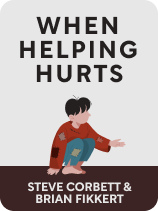

This article is an excerpt from the Shortform book guide to "When Helping Hurts" by Steve Corbett and Brian Fikkert. Shortform has the world's best summaries and analyses of books you should be reading.
Like this article? Sign up for a free trial here.
What is the book When Helping Hurts about? What should you take away from the book?
Since the 1980s, short-term mission trips have become a popular form of ministry for many evangelical Christian churches throughout North America. Steve Corbett and Brian Fikkert express concern that many of these missions do more harm than good.
Read below for a brief overview of their book When Helping Hurts.
When Helping Hurts by Steve Corbett and Brian Fikkert
In their book When Helping Hurts, Steve Corbett and Brian Fikkert, two experts in finance and poverty alleviation working at the Chalmers Center, a Christian non-profit, explain how poverty relief efforts can reinforce the recipients’ sense of powerlessness, especially when administered in a spirit of paternalism. When this happens, it undermines the program’s effectiveness because the sense of powerlessness is an even more fundamental component of poverty than a lack of physical resources.
Most of Corbett and Fikkert’s observations come from Christian ministries to the poor, and the authors also have a background in evangelical Christianity. The book’s original target audience was North American Christians, and especially church leaders who might be involved in planning short-term missions or other programs to help the poor. While we’ve preserved the authors’ advice to church leaders in this guide, we’ll also explore the implications of their advice for people outside of Christianity.
The Problems With Current Poverty Alleviation Efforts
Corbett and Fikkert identify a number of problems that commonly affect short-term missions and poverty alleviation efforts. Combining a few of the more closely related ones, we can present them as three basic mistakes: providing aid with the wrong mentality, providing the wrong kind of aid, and having the wrong people administer it.
Providing Aid With the Wrong Mentality
Corbett and Fikkert assert that thinking of poverty in strictly material terms is problematic because it leads us to provide assistance in ways that actually make the root of the problem worse.
(Shortform note: Other authors have applied the principle that trying to solve a problem before you correctly define its root cause can be counterproductive to a variety of problems other than poverty. For example, in Principles: Life and Work, Ray Dalio discusses the importance of identifying root causes when solving business problems.)
The authors cite extensive studies showing that when poor people are asked what it means to be poor, they tend to define poverty in terms that are more psychological than physical. From this, they deduce that poverty is fundamentally a mental state of shame and powerlessness more than a physical lack of money or other resources.
There is still a connection between material and psychological poverty: Not having the resources to take care of yourself and your family tends to produce a mental state of shame and powerlessness. And this mental state saps your initiative, which hinders your efforts to earn money or accumulate wealth, creating a vicious cycle.
Providing the Wrong Kind of Aid
Even if you understand the psychological nature of poverty, applying the wrong approach to poverty alleviation can still do more harm than good. Before we discuss how the wrong type of aid can do more harm than good, we need to go over the basic types of aid that disaster victims and impoverished people may need.
Classifying Types of Aid
According to Corbett and Fikkert, there are three basic types of aid:
- Relief consists of providing immediate assistance to people in a time of crisis, bringing in outside resources to prevent a bad situation from getting worse.
- Rehabilitation consists of helping people to recover from a crisis. The relief phase begins as soon as the situation stabilizes and concludes when pre-crisis conditions have been restored.
- Development consists of empowering people to improve their situation beyond what it’s been in the past. The authors assert that development should involve a mutually beneficial relationship between the person providing aid and the person receiving it.
For example, imagine your neighbor’s house was destroyed by a tornado. Letting him stay in your guest bedroom free of charge for a while is relief. Lending a hand as he rebuilds his house is rehabilitation. Spending time strategizing with him about how you can both be better prepared for the next tornado season is development.
The Wrong People Provide the Aid
Even if you understand the nature of poverty and correctly identify the type of aid that a person or group needs, Corbett and Fikkert argue that, depending on the situation, you may not be the right person to provide that aid.
By way of illustration, imagine that your friend is suffering from appendicitis. He needs an appendectomy. Should you try to remove his appendix? Unless you’re a trained surgeon with suitable facilities available for performing an operation, probably not. It would be much better to let a doctor who has the right training and equipment perform the appendectomy.
Similarly, Corbett and Fikkert argue that the best people and organizations to provide aid are usually the ones closest (both geographically and culturally) to the people who are in need. Local churches (or other organizations) in poor communities are in a much better position to engage members of their own community effectively because they have a better understanding of their situation. And they’re better able to help them improve their situation over the long term because their close proximity makes it easier to maintain long-term relationships.
The Solution to Providing Better Poverty Alleviation
Now that you understand how traditional methods of helping the poor like giving them things or building infrastructure for them can end up doing more harm than good, what can you do to help? We’ve condensed Corbett and Fikkert’s advice down to a three-step solution:
- Cultivate humility
- Collaborate with those who can provide the best aid
- Connect with the people you want to help

———End of Preview———
Like what you just read? Read the rest of the world's best book summary and analysis of Steve Corbett and Brian Fikkert's "When Helping Hurts" at Shortform.
Here's what you'll find in our full When Helping Hurts summary:
- How many Christian church missions actually do more harm than good
- A look into the true nature and causes of poverty
- Suggestions for how to help the poor more effectively






